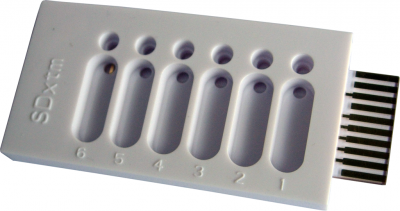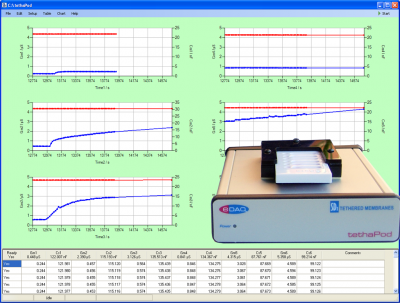SDx Protocol 1
This protocol is suitable for the measurement of tethered membrane conductivity with most ionophores, and other low molecular weight (2000 Da or less) ion channels, using a tethaPod™ and tethaPlate system.
Make sure you are familiar with the concept of tethered membranes and use of the tethaPod software.
Membrane formation
Assemble the tethaPlate as per its instructions. To each well add 10 µL AM199 lipid mixture, and incubate for 2 minutes to allow the phospholipid bilayer membrane to form. Now add 200 µL PBS per well followed immediately by three 200 µL PBS rinses.
Stock solution
Make a 1 mM stock solution of the ionophore in methanol. Using the method of serial dilution prepare a series of solutions in decade concentration increments, allowing 200 uL per test well so that you have solutions of 1, 10, 100, 1000, 10000 nM. The 10000 nM solution will still contain only 1% methanol, which means that the solution is mainly water. Higher methanol concentrations can disrupt the membrane, or allow incomplete partitioning of the ionophore into the lipophillic membrane.
If you need to use more concentrated test solutions then you will need to make a more concentrated stock solution (eg 10 or even 100 mM) and dilute these down to the desired levels.
Ionophore Addition
Ensure all solutions are thermally equilibrated at room temperature before starting.
Start recording with the tethaPlate fitted to the tethaPod unit, proceed for several minutes until stable baseline signals are obtained for each of the sample wells.
- Withdraw 200 µL of the PBS buffer from the tethaPlate well.
- Note the time and replace with 200 µL test solution at lowest ionophore concentration.
- Record the membrane conductivity for at least 5 minutes, or until the signal plateaus.
- Withdraw 200 µL of the old test solution from the tethaPlate well.
- Note the time and replace with 200 µL test solution at the next higher ionophore concentration.
- Record the membrane conductivity for at least 5 minutes, or until the signal plateaus.
- Repeat from step 4 to step 6, until the highest ionophore concentration is reached (or until the membrane ruptures)
- Withdraw 200 µL of the old test solution from the tethaPlate well.
- Replace with 200 µL of the PBS buffer.
- Repeat steps 8 - 9 every minute three times, and observe whether the ionophore can be 'washed out'.
Prepare a graph of conductivity vs log of ionophore concentration.
It is usual to find that there is a sudden rise in conductivity over a single decade of concentration increase. If you want better resolution on your graph then repeat the experiment using a series of test solutions prepared over this smaller concentration range.

